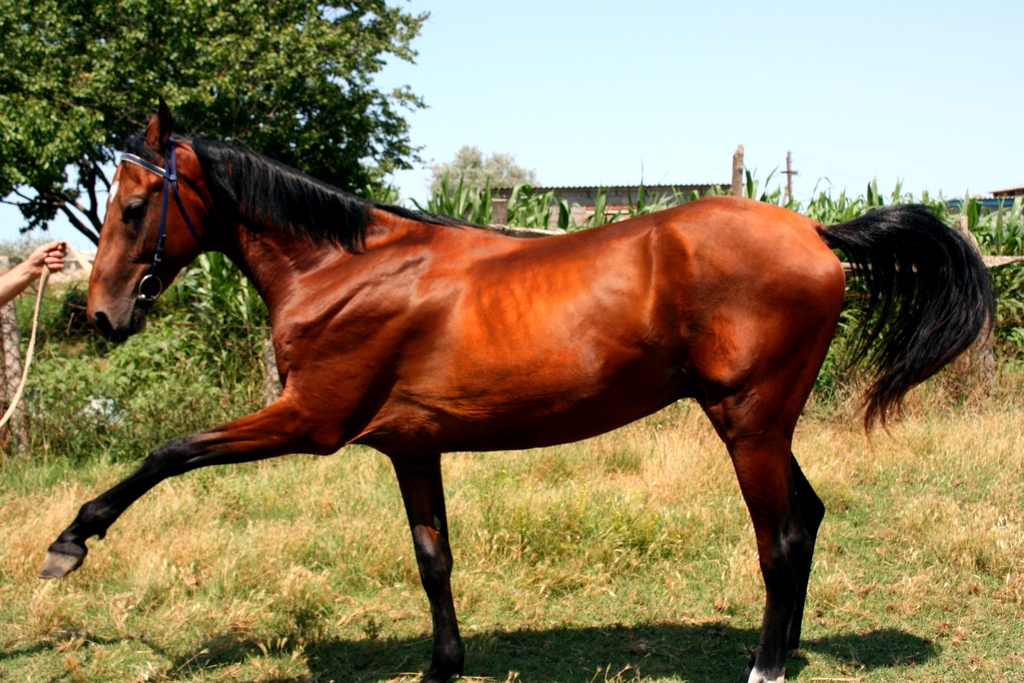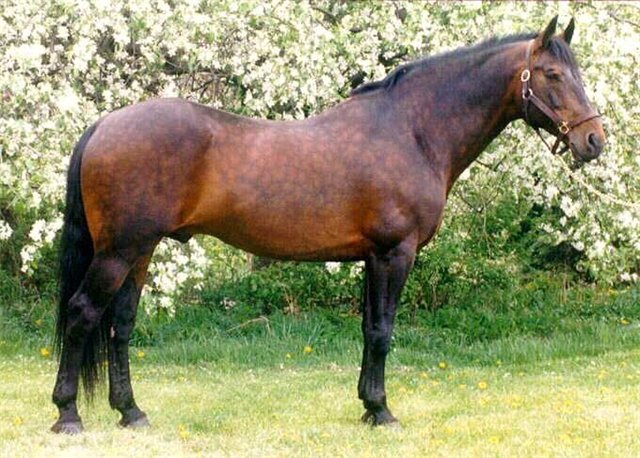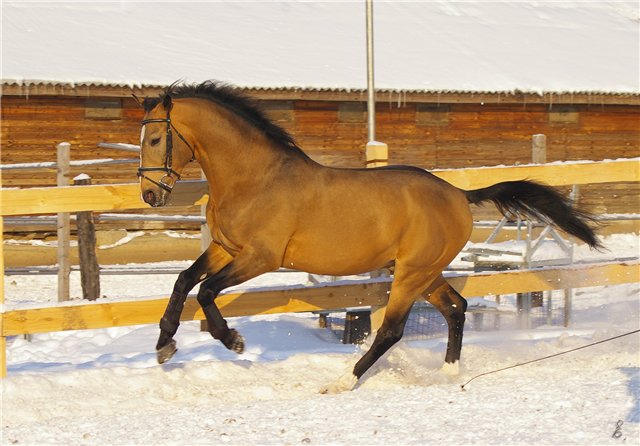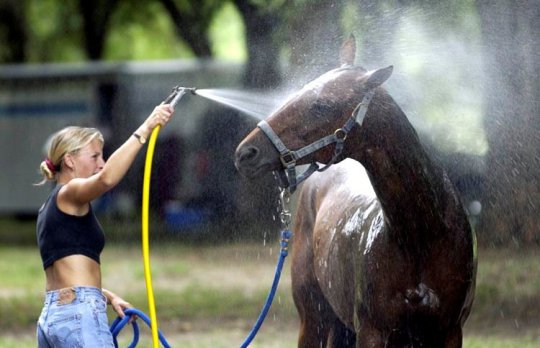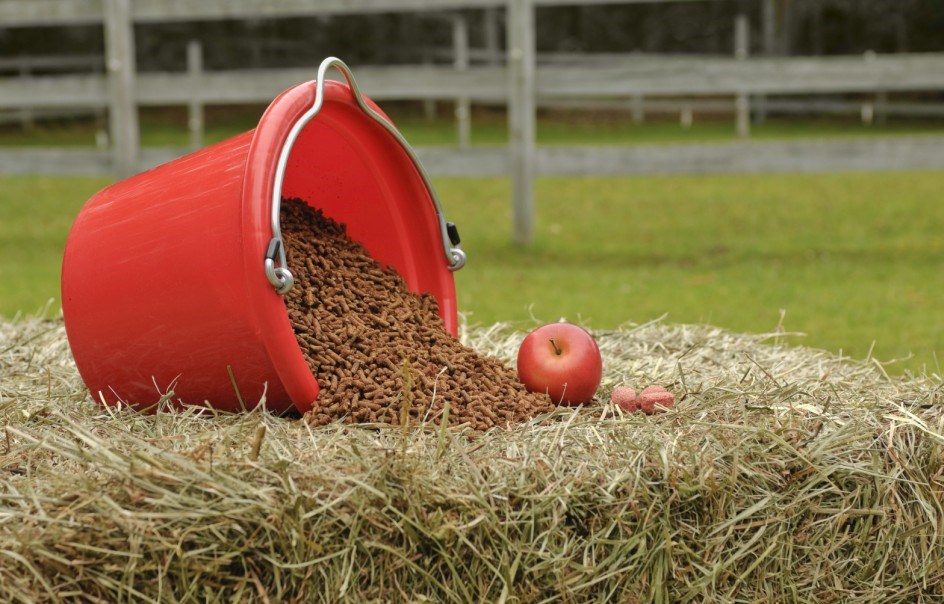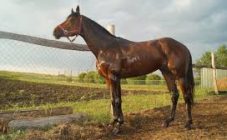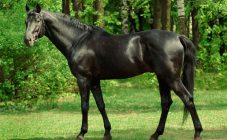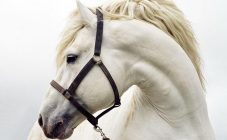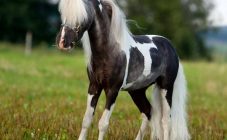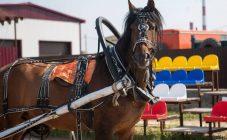Content:
The first thing we notice when we see a horse is its color. This is not just a color, but a whole complex of traits determined at the genetic level. It is interesting that even Hippocrates was engaged in the classification of horses by color. Its division was based on the idea of the world as consisting of four elements. Genetics comes to the aid of modern horse breeders, which makes it possible to unambiguously classify any animal.
A bay horse - what color is it
A characteristic feature of the chestnut suit is the body in chocolate tones. Its shades have a very wide range of colors: from light brown to deep dark brown. The luxurious mane, tail and legs are black, which emphasizes the beauty of the animal. It is not for nothing that in the culture of many peoples the bay horse is a symbol of fire, which is associated with flame and burning.
History and origins
The gray horse is considered the ancestor of the modern bay horse. Przewalski's horse can be called a striking representative. The duck color of a horse is characterized by a light red body color and black legs, tail, and mane. But unlike the bay color, the color is not clean.
Scientists do not have an unambiguous answer about the origin of the name of the suit. It is believed that the word "bay" reflects the appearance of horses. According to one version, it comes from the old Russian "oppress", which meant "to kindle a fire." In the Latin language there is a word "nidor", which is similar not only in spelling, but also in meaning - "smoke, fumes". Likewise, the ancient Greek "knissa" means "burnt."
In the countries of the East, there is even a legend about the origin of this color. According to her, one day a herd of white horses came to a lake filled to the brim with dragon's blood. The horses spent the whole night by the reservoir, and in the morning a herd of bay horses appeared in place of the snow-white animals. Their bodies became as bright as fire, and their legs burned like coals.
Genetics
The coloration of any horse is strictly defined at the genetic level. The suit is determined by a combination of 2 main genes: Extention and Agouti. It is they who, in different combinations, determine one of the three main colors. Other suits are formed as a result of incomplete dominance of 2 basic genes. Primarily, the bay horse carries the autosomal gene E, which is present in the DNA of every brown horse. He is responsible for the synthesis of melanocortin and the formation of the desired pigment in the hairline.
The second gene, Agouti, is no less important. It prevents the appearance of black color in a horse and is responsible for the synthesis of a peptide, which in turn contributes to the production of pheomelanin, which is responsible for brown pigmentation.
This is confirmed in practice, since when crossing bay horses there is such a probability of the birth of foals: 9 bay, 3 black and 4 red.
External description
The bay suit belongs to the basic colors and was created by nature itself.As noted earlier, the body of the bay mare is colored shades of brown, while the tail, mane and part of the legs below the hock are black.
There are other characteristics too:
- Despite the fact that the main color is brown, the coat includes black hairs. Thus, a unique burning effect is created, which gave the name to the suit.
- The skin of an adult animal is gray, and at birth, the skin of a foal is pink.
- The eyes are usually brown.
Color options
Despite the typical signs of color, color options can vary greatly. The horse's croup can be either light with a yellowish tinge or deep dark brown. Among the representatives of modern breeds, dark color variations are much more common. Among all the variety, there are several main options:
- Light coloured. The horse's body is almost sandy in color, so it can sometimes be mistaken for an animal of a dun color. A rather dark belt runs along the ridge. The tail and mane are also slightly lighter than in the basic version, and there are light spots around the lips and eyes.
- Dark. In this case, the head, part of the croup and back are darker in color, while the rest of the body is brown.
- Chestnut. In a horse of this color, the body has a uniform, rich chestnut shade.
- Deer. This color differs from the standard bay suit in a lighter shade of the head and abdomen.
- Mukhortaya. It is brown in color with light spots around the eyes and lips, in the groin area and sometimes on the elbows and around the buttocks.
- Cherry. A very beautiful brown horse with a pronounced reddish tint. Sometimes these horses are called fiery.
- Golden. A rare color that is highly prized. The tone of the coat is yellow-brown with a pronounced golden tint.
- Karakova. Almost a black horse, it can be called an intermediate version between the bay and the crow.
Features, disposition and behavior
Since ancient times, horse breeders have tried to establish a connection between the color of the horse and its disposition. The Arabs were the first to associate the suit not only with character, but also with physical capabilities. In their opinion, it is the bay stallions that are of the greatest value. The same conclusion can be drawn from the results of equestrian sports, where most of the medals and achievements belong to the bay horses.
Horse connoisseurs distinguish a number of qualities that distinguish the representatives of the bay suit:
- endurance;
- strong muscles;
- high speed;
- perky, but at the same time balanced character.
At the same time, it has been proven that due to the fact that the color is transmitted genetically, hereditary diseases are transmitted along with it. The bay color is not associated with any diseases and this explains the endurance and good health of such horses.
Care
Such horses do not require any special conditions of keeping. The main thing is to equip a warm dry stable and ensure the complete absence of drafts.
Regular hygiene procedures will help maintain the beauty and health of the animal. You need to clean the horse at least once every 3 days, be sure to wipe it with clean water. It is recommended to check the hooves on a daily basis so as not to miss the appearance of cracks or cuts.
Diet and feeding
The basic rules for feeding any horse are based on the structural features of its digestive system. It is important to know that horses do not have a gallbladder and the bile produced by the liver cannot process heavy food.All feed should be exclusively of vegetable origin, as easy to digest as possible and have a high energy value in order to replenish the energy expended in races or agricultural work.
The basic rules of feeding should be observed:
- To avoid colic, it is important to rest the animal before and after feeding. Rest time should be at least 1 hour, and preferably 1.5. If you do not follow this regime, the horse can become seriously ill and even die.
- It is imperative to feed in small portions: 4 to 8 times a day. Feeding should be regular so that the food is better absorbed.
- A horse needs about 40 liters of water a day, and in the summer heat - up to 80. It is important to ensure that the water is not too cold, especially if the horse is sweating. You can water the horse before or after feeding.
The diet should include the following plant foods:
- Grass. In summer, it serves as the main feed in combination with concentrates. Fresh grass is very nutritious, contains protein, sugar, essential vitamins.
- Hay and straw. The quality of the hay must be monitored: it must be properly dried and free of mold. Dry grass that is improperly stored can be hazardous to health. The straw is low in calories and is used for bedding. This roughage should make up about 40% of the diet. You need to give it all year round.
- Haylage. It differs from ordinary hay in that the grass is dried in tightly packed bales. This feed contains more water than regular hay.
- Corn. For example, oats, which are highly digestible.
- Silage. Such food must be properly prepared, otherwise, in case of problems with fermentation, it can have a bad effect on digestion.
- Bran. As a rule, they are consumed in the form of cereals.
- Vegetables and fruits. This is a healthy, vitamin-rich treat.
Now even beginners figured out which horse is called a bay. A fiery horse with a developing coal-black mane will not leave anyone indifferent. Moreover, they can be found both at elite races and in agriculture.
